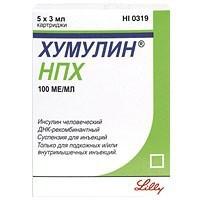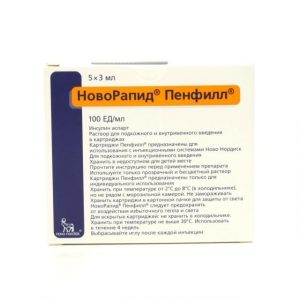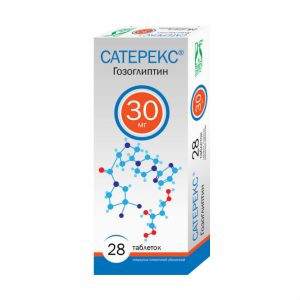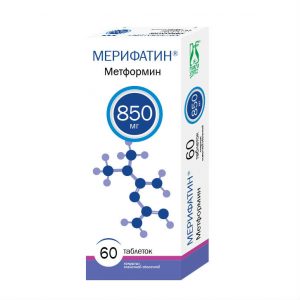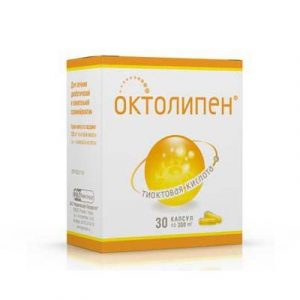Description
Packaging
5 cartridges of 3 ml.
Pharmacological action
Humulin NPH – DNA recombinant human insulin. It is a medium-acting insulin preparation. The main effect of the drug is the regulation of glucose metabolism. In addition, it has an anabolic effect. In muscle and other tissues (with the exception of the brain), insulin causes rapid intracellular transport of glucose and amino acids, accelerates protein anabolism. Insulin promotes the conversion of glucose to glycogen in the liver, inhibits gluconeogenesis and stimulates the conversion of excess glucose to fat.
Pharmacokinetics
Humulin NPH is a medium-acting insulin preparation.
The onset of the drug is 1 hour after administration, the maximum effect is between 2 and 8 hours, the duration is 18-20 hours.
Individual differences in insulin activity depend on factors such as dose, choice of injection site, physical activity of the patient.
Indications
– Diabetes mellitus if indicated for insulin therapy.
– Newly diagnosed diabetes mellitus.
– Pregnancy in type 2 diabetes mellitus (non-insulin dependent).
Contraindications
– Hypoglycemia.
– Hypersensitivity to insulin or to one of the components of the drug.
Use during pregnancy and lactation
During pregnancy, it is especially important to maintain good glycemic control in patients with diabetes mellitus. During pregnancy, the need for insulin usually decreases in the first trimester and increases in the second and third trimesters. It is recommended that patients with diabetes mellitus inform the doctor about the onset or planning of pregnancy. In patients with diabetes mellitus during lactation (breastfeeding), a dose adjustment of insulin, diet, or both can be required. In studies of genetic toxicity in the in vitro and in vivo series, human insulin did not exert a mutagenic effect.
Special instructions
It is recommended that you take an insulin preparation (any replacement of insulin should be done with caution and only under medical supervision) in case of damage to or loss of the pen injector or cartridge) in a vial and syringe for drug administration. The transfer of the patient to another type of insulin or to an insulin preparation with a different trade name should occur under strict medical supervision. Changes in the activity of insulin, its type (for example, M3, NPH), species (porcine, human insulin, human insulin analogue) or production method (DNA recombinant insulin or insulin of animal origin) may require dose adjustment.
The need for dose adjustment may be required already at the first administration of a human insulin preparation after an animal insulin preparation or gradually over the course of several weeks or months after transfer. The need for insulin may decrease with insufficient adrenal function, pituitary or thyroid gland, with kidney or liver failure. With some diseases or with emotional stress, the need for insulin may increase.
Dose adjustment may also be required with increased physical activity or with a change in normal diet.
Symptoms of the precursors of hypoglycemia during administration of human insulin in some patients may be less pronounced or different from those that were observed during administration of animal insulin. With normalization of blood glucose levels, for example, as a result of intensive insulin therapy, all or some of the symptoms that precursor to hypoglycemia may disappear, which patients should be informed about. Symptoms of the precursors of hypoglycemia may change or be less pronounced with a prolonged course of diabetes mellitus, diabetic neuropathy, or with the use of beta-blockers.
In some cases, local allergic reactions can be caused by reasons not related to the action of the drug, for example, skin irritation with a cleansing agent or improper injection.
In rare cases of systemic allergic reactions, immediate treatment is required. Sometimes, insulin changes or desensitization may be required.
Insulin demand may decrease with liver failure. The need for insulin may decrease with renal failure.
Effect on the ability to drive vehicles and control mechanisms: during hypoglycemia, the patient’s ability to concentrate and decrease the speed of psychomotor reactions may decrease. This can be dangerous in situations in which these abilities are especially necessary (driving a car or operating machinery). Patients should be advised to take precautions to avoid hypoglycemia while driving. This is especially important for patients with mild or absent symptoms-precursors of hypoglycemia or with frequent development of hypoglycemia. In such cases, the doctor must evaluate the feasibility of the patient driving the car.
Composition of
1 ml of suspension for subcutaneous administration contains:
active substance: isofan-insulin srl41dff100 EF 1 suspension for subcutaneous administration contains: active substance: insulin-isophan (human genetic engineering) 100 IU,
excipients: metacresol, glycerol, phenol, protamine sulfate, sodium hydrogen phosphate, zinc oxide, water for injection, hydrochloric acid 10% and sodium hydroxide solution 10% (to create the required pH level).
Dosing and Administration
The dose is determined by the doctor individually, depending on the level of glycemia. The drug should be administered sc, possibly in / m introduction. In / in the introduction of Humulin NPH is contraindicated! The SC drug is administered to the shoulder, thigh, buttock or abdomen. The injection site must be alternated so that the same place is used no more than about 1 time / month. When s / to the introduction, care must be taken to avoid getting into the blood vessel. After the injection, the injection site should not be massaged. Patients should be trained in the proper use of insulin devices.
Rules for the preparation and administration of the drug
Humulin NPH vials should be rolled between the palms 10 times before use and shaken, turning 180 ° also 10 times to resuspend insulin until it becomes a uniform turbid liquid or milk. Shake vigorously, as this can lead to the appearance of foam, which can interfere with the correct dose. Vials should be carefully checked. Do not use insulin if it contains flakes after mixing, if solid white particles adhere to the bottom or walls of the vial, creating the effect of a frosty pattern. The contents of the vial should be filled into an insulin syringe corresponding to the concentration of insulin administered, and the desired dose of insulin should be administered as directed by the doctor. Using the outer needle cap, immediately after insertion, unscrew the needle and destroy it safely. Removing the needle immediately after injection ensures sterility, prevents leakage, air ingress and possible clogging of the needle. Needles should not be reused. Needles should not be used by others. Vials are used until they become empty, after which they should be thrown away. Humulin NPH can be administered in combination with Humulin Regular. For this, short-acting insulin should be drawn into the syringe first to prevent longer-acting insulin from entering the vial. It is advisable to introduce the prepared mixture immediately after mixing. To administer the exact amount of each type of insulin, you can use a separate syringe for Humulin Regular and Humulin NPH. You should always use an insulin syringe that matches the concentration of insulin injected.
Side effects
Side effect associated with the main effect of the drug: hypoglycemia. Severe hypoglycemia can lead to loss of consciousness and (in exceptional cases) death.
Allergic reactions: local allergic reactions are possible – hyperemia, swelling or itching at the injection site (usually stop within a period of several days to several weeks) systemic allergic reactions (occur less often, but are more serious) – generalized itching, shortness of breath, shortness of breath , decreased blood pressure, increased heart rate, increased sweating. Severe cases of systemic allergic reactions can be life threatening.
Other: the likelihood of developing lipodystrophy is minimal.
Drug interactions
Hypoglycemic effect of Humulin NPH reduces oral contraceptives, corticosteroids, thyroid hormone preparations, thiazide diuretics, diazoxide, tricyclic antidepressants.
Hypoglycemic effect of Humulin NPH is enhanced by oral hypoglycemic drugs, salicylates (e.g. acetylsalicylic acid), sulfonamides, MAO inhibitors, beta-blockers, ethanol and ethanol-containing drugs.
Beta-blockers, clonidine, reserpine can mask the manifestation of symptoms of hypoglycemia.
Pharmaceutical Interactions
Effects, arising from the mixing of human insulin with insulin of animal origin or human insulin produced by other manufacturers have not been studied.
Overdose
Symptoms: hypoglycemia, accompanied by lethargy, increased sweating, tachycardia, pallor of the skin, headache, tremors, vomiting, confusion. Under certain conditions, such as long duration or intensive control of diabetes, the symptoms of hypoglycemia may change.
Treatment: mild hypoglycemia can usually be stopped with glucose (dextrose) or sugar. Adjustment of insulin dose, diet, or physical activity may be required. Correction of moderate hypoglycaemia can be performed by means of / m or p / to the introduction of glucagon, followed by intake of carbohydrates. Severe conditions of hypoglycemia, accompanied by coma, convulsions or neurological disorders, stop in / m or p / to the introduction of glucagon or in / in the introduction of a concentrated solution of glucose (dextrose). After regaining consciousness, the patient should be given carbohydrate-rich foods to avoid hypoglycemia.
Storage conditions
The product should be stored in the refrigerator at 2 ° to 8 ° C, to prevent freezing and to avoid direct exposure to light and heat. The drug in use in the cartridge should be stored at room temperature (15 ° to 25 ° C) for no more than 28 days.
Active ingredient
Insulin-isophan human gene but-engineering
Conditions granted through pharmacies
In retseptu
Le drug form
solution for injection
